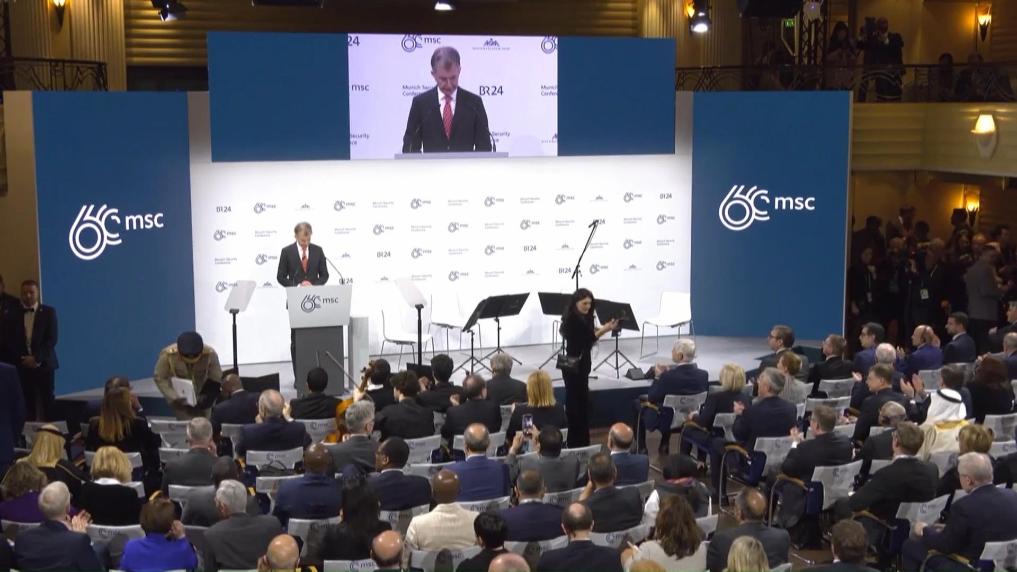
by Liu Zhoupeng
LHASA, Feb. 19 (Xinhua) -- During the Spring Festival holiday season, I had the privilege of accompanying railway workers on a maintenance journey across the plateau in southwest China's Xizang Autonomous Region, navigating through extreme conditions resembling "ice and fire."
As I joined a convoy of vehicles ascending the mountain at the Gyaca Bridge and Tunnel section, part of the railway connecting the region's major cities of Lhasa and Nyingchi, the Yarlung Zangbo River below revealed its clear and turquoise waters. The dark brown Zam Bridge, with its arch crown and 86 white suspender cables connecting to the deck, resembled a colossal harp, gracefully stretching across both riverbanks.
The bridge, constructed as a concrete-filled steel tube arch, is at the world's highest altitude at 3,350 meters and boasts the longest span measuring 430 meters. During winter, the vertical distance between its deck and the surface of the Yarlung Zangbo River exceeds 30 meters, according to a worker.
To ensure the bridge's safety and unimpeded access, workers must climb hundreds of narrow stairs along the arch to reach its top, which stands over 100 meters above the surface of the river.
"It feels as if we're walking through the clouds," said Zhang Liang, deputy foreman of the Gyaca Bridge and Tunnel section.
I looked up from the bridge and saw the workers, clad in bright yellow safety vests, gradually ascending higher and appearing smaller along the arch.
Over the past two years, maintenance workers have had to inspect the bridge every week regardless of the extreme weather, especially the wind, which has a maximum speed of up to 37 meters per second.
Zhang recalled his maiden mission in 2021, the first year of the railway's operation. By the time the inspection of all components was completed, it was already nightfall. The valley wind intensified, compelling him to tightly grip the handrail with both hands while pressing his body close to the stairs.
He said that even after scaling the top of the arch numerous times, every time he peered down into the river, his legs would shake uncontrollably. Looking down at the tranquil river far below from the towering deck, and then up at the top of the arch reaching towards the sky, his mood suddenly echoed within me.
While on the bridge, the wind deflectors on both sides produced a constant hum. Despite wearing thick gloves and winter clothing, the chill persisted. "The cold metal and welds seem like ice stabbers to our hands," said Zhang, explaining the importance of every single screw in the construction of the plateau bridge.
Bidding farewell to the bitter cold Zam bridge, we entered the longest tunnel along the railway -- the 17.3-kilometer-long Dakarlha tunnel. Here, the high temperature generated by geothermal energy inside posed another challenge.
A sudden wave of hot steam caught me off guard, instantly fogging my eyeglasses and camera lens.
During the 3.5-kilometer walk through the tunnel, workers used inspection hammers to tap on the sidewalls, gauging the concrete compactness, identifying cavities, and assessing other wall conditions based on the resulting sounds.
I also heard sounds of water nearby and in the distance. The Qinghai-Xizang Plateau is known as the "Asian water tower" and is home to numerous mountains and glaciers. Their surfaces are covered by a large amount of glacial debris, which is loose and porous, allowing a large amount of water to infiltrate and gather into rich underground water resources.
The area of the Dakarlha Tunnel experiences frequent rainfall, resulting in abundant underground water resources.
I dipped my fingers into the hot water flowing in the drainage channel by the sidewall, and it felt like a comfortable temperature for a bath.
As we went deeper into the tunnel, the temperature gradually picked up, and my hair under the helmet was soaked with sweat. The maximum temperature in the tunnel can reach 39 degrees Celsius on a regular winter night.
"When the railway first opened, we had to walk through the entire tunnel, enduring temperatures as hot as a sauna," said Dong Shengrui, another deputy foreman of the Gyaca Bridge and Tunnel section. He said that they would often exit the tunnel by late morning, noting that now the tunnel has been equipped with many service roads, making it more convenient for maintenance.
This inspection work usually occurs from the evening into the next day. The team inspects each beam, bearing and walking board on the bridge, as well as every drainage cover plate, joint and other components in the tunnel.
Each inspection entails walking more than 5 kilometers, said Dong. "A pair of protective footwear wears out every three months."
It was already the next day when we exited the tunnel, and it felt like being pulled back into an ice cellar from a greenhouse.
Despite being drenched in sweat after walking for more than four hours, Dong still greeted his wife with a smile when he finally had the opportunity to video call her.
Phurbu Tsering, a 25-year-old maintenance worker from Nyingchi, said it was his third time carrying out duties during the Spring Festival.
"I am committed to my responsibilities, ensuring the safety of the railway so that more people can return home safe and sound," Phurbu Tsering said as he watched the trains pass by smoothly. ■












